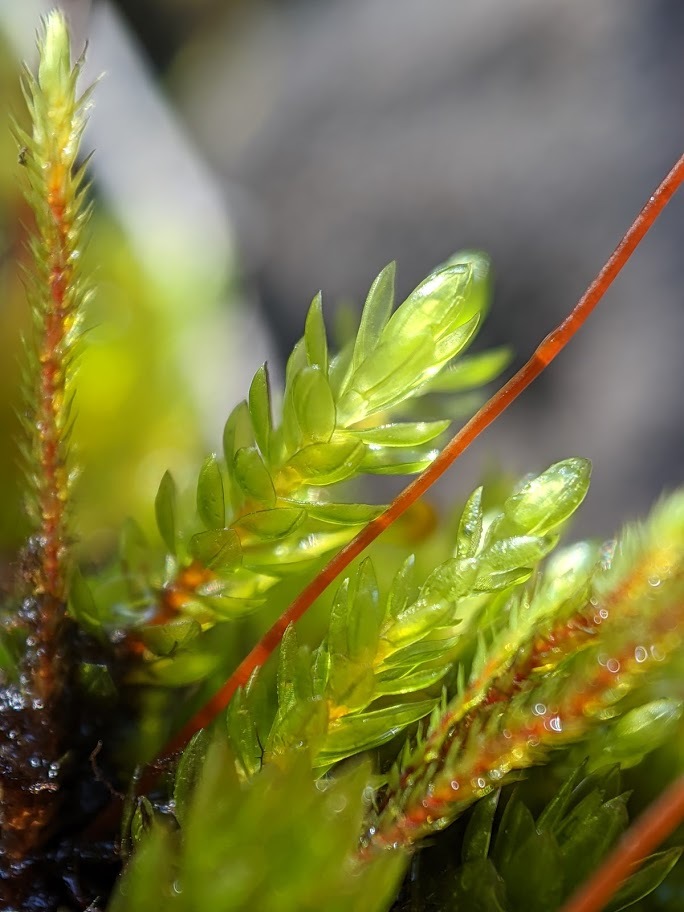Ptychostomum
Dioicous, synoicous, autoicous (not in Victoria) or polyoicous (not in Victoria). Asexual reproduction by rhizoidal tubers or axillary filamentous gemmae. Turves or tufts on soil, rocks or rarely logs or tree bases. Stem erect, often branched by innovation, with sparse rhizoids to tomentose; central strand present. Leaves ovate or elliptic to lanceolate, obovate or spathulate, rarely rosulate, erect or erect-spreading when moist or dry or slightly crisped or twisted to distinctly spirally twisted around stem when dry; apex rounded (not in Victoria), obtuse, acute or acuminate; costa subpercurrent (not in Victoria), percurrent or excurrent; margin entire or denticulate toward apex, plane or recurved, with or without a border of elongated cells, sometimes bistratose (not in Victoria); laminal cells hexagonal or rhomboid, becoming rectangular toward base and often red, smooth; alar cells often swollen or inflated, pink or red, or not differentiated and green. Capsule inclined to pendent, straight or curved, pyriform, oblong or cylindric, with a revoluble annulus. Peristome double; exostome strongly reduced (not in Victoria) to similar height as endostome; endostome well-developed, with a high or low basal membrane; cilia present, rudimentary or absent (not in Victoria).
Worldwide with around 80 species, but genus limits uncertain (see below); six species in Victoria.
Spence (2005) resurrected Ptychostomum for Bryaceae with a combination of non-rosulate leaves, laminal cells that are rhomboid or hexagonal and broad, which become more elongated and rectangular toward the leaf base, reduced peristomes, and usually an absence of specialised asexual propagules (Spence & Ramsay 2006). However, phylogenies of DNA sequences from all genomic compartments have shown that several species are closely related to this concept of Ptychostomum but differ significantly in their morphology (e.g. Pedersen et al. 2007) and that Ptychostomum under the circumscription of Spence (2005) may be too narrow. All species placed in this genetic lineage that includes Ptychostomum have alternatively been included in a broader Ptychostomum adopted here (Holyoak & Pedersen 2007) and includes Victorian P. capillare (Hedw.) D.T.Holyoak & N.Pedersen and P. rubens (Mitt.) D.T.Holyoak & N.Pedersen, previously included in Rosulabryum and Gemmabryum by Spence & Ramsay (2006) respectively. This genus, while possibly monophyletic, is morphologically heterogeneous and lacks defining features that could be used to distinguish it from other Bryaceae genera (Pedersen & Hedenäs 2005; Holyoak & Pedersen 2007). Many species have leaves with reddish basal cells, however, this is not shared by all species in Ptychostomum (Holyoak & Pedersen 2007). Future research is required to better establish which species belong to this major lineage of Bryaceae and morphological features that are largely associated with it.
 Spinning
SpinningHolyoak, D.T.; Pedersen, N. (2007). Conflicting molecular and morphological evidence of evolution within the Bryaceae (Bryopsida) and its implications for generic taxonomy. Journal of Bryology 29: 111–124.
Pedersen, N.; Hedenäs, L. (2005). Taxonomic and nomenclatural implications of phylogenetic studies of the Bryaceae based on molecular data and morphology. The Bryologist 108: 123–128.
Pedersen, N., Holyoak D.T.; Newton, A.E. (2007). Systematics and morphological evolution within the moss family Bryaceae: A comparison between parsimony and Bayesian methods for reconstruction of ancestral character states. Molecular Phylogenetics and Evolution 43: 891–907.
Spence, J.R. (2005). New genera and combinations in Bryaceae (Bryales, Musci) for North America. Phytologia 87: 15–28.
Spence, J.R.; Ramsay, H.P. (2006). Bryaceae, in McCarthy, P.M. (ed.), Flora of Australia. Vol. 51 Mosses 1, pp. 274–348. ABRS, Canberra.


